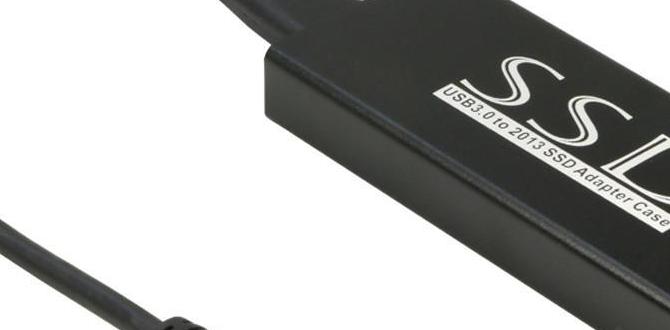Quick Summary: For your remote control, AA or AAA alkaline batteries are usually the best, most affordable choice for everyday use. They provide reliable power for a long time and are easy to find. For devices needing more power or frequent use, rechargeable options can save money and reduce waste.
Choosing the Right Small Battery for Your Remote: A Simple Guide
Does your remote sometimes die right when your favorite show is on? It’s a common frustration! Figuring out the right small battery for your remote can feel confusing with so many types out there. But don’t worry, it’s simpler than you think. This guide will help you pick the perfect battery, understand your options, and keep your devices powered up without a hassle. We’ll break down everything you need to know, step-by-step.
Understanding Common Small Batteries
When we talk about “small batteries” for remotes and other gadgets, we’re usually talking about a few main types. Each has its own strengths and is best suited for different uses. Let’s look at the most popular ones you’ll encounter.
Alkaline Batteries (AA, AAA, C, D, 9V)
These are the most common batteries you’ll find in stores and homes. Think of the typical AA batteries you pop into your TV remote. They are inexpensive and great for devices that don’t use a lot of power or are used only sometimes.
- Pros: Affordable, widely available, good shelf life (they can sit for years without losing much power).
- Cons: Not rechargeable, can leak if left in a device for too long, not ideal for high-drain devices.
- Best for: Remote controls, clocks, wireless mice, smoke detectors, toys.
Lithium Batteries (AA, AAA, Coin Cells)
These are a step up from alkaline. They last longer and can operate in a wider range of temperatures. You’ll often see them in digital cameras, high-drain remotes, or even in small medical devices.
- Pros: Longer life than alkaline, perform better in extreme temperatures, lighter weight.
- Cons: More expensive than alkaline.
- Best for: High-tech gadgets, devices needing long-lasting power, extreme temperature conditions.
Rechargeable Batteries (NiMH – AA, AAA)
Rechargeable batteries, most commonly Nickel-Metal Hydride (NiMH), are a fantastic choice if you use batteries frequently. You buy them once, and then you can recharge them hundreds or even thousands of times using a special charger. While the initial cost is higher, they save you money and reduce waste over time.
- Pros: Reusable, cost-effective in the long run, better for the environment.
- Cons: Higher upfront cost, require a separate charger, can lose charge over time if not used (self-discharge, though modern ones are much better).
- Best for: Game controllers, digital cameras, toys, devices used daily.
Button Cells / Coin Cells (Lithium, Alkaline)
These small, round batteries are often found in watches, key fobs, calculators, and small electronic devices. They’re designed for low-power, long-term use.
- Pros: Small size, long life in low-drain devices.
- Cons: Can be a choking hazard for children and pets, must be replaced, specific types needed for specific devices.
- Best for: Watches, keyless entry fobs, small calculators, hearing aids (specialized ones).
What is the “Expert Small Battery” for a Remote?
When people ask about the “expert small battery” for a remote, they’re often looking for the most reliable and cost-effective option that balances performance with ease of use and availability. For the vast majority of standard remote controls (TV, DVD player, stereo), the expert choice is a high-quality alkaline AA or AAA battery.
Why? Because standard remotes are low-drain devices. They don’t need a super-powered battery. Alkaline batteries provide sufficient power for a long time, are incredibly easy to find at almost any store, and are budget-friendly. Brands like Duracell, Energizer, or even reliable store brands offer excellent performance in this category.
If your remote uses a lot of power (like a gaming controller or a backlit remote) or you’re constantly replacing batteries, then exploring rechargeable AA or AAA NiMH batteries becomes the expert long-term solution. While the initial buy-in is higher for the batteries and charger, the savings and convenience over time are significant.
How to Choose the Best Battery for Your Specific Remote
The best battery isn’t just about the type; it’s about matching the battery to your specific needs and the device itself. Here’s a simple process:
- Check Your Device’s Manual or Battery Compartment: The first and most important step! Your remote will have a label inside the battery compartment or in its manual specifying the exact battery type needed (e.g., AA, AAA, CR2032). Always try to stick to this recommendation.
- Consider Power Consumption:
- Low Power Use (Standard Remotes): For basic TV remotes, fan remotes, or garage door openers, good quality alkaline AA or AAA batteries are perfect.
- Medium to High Power Use (Gaming Controllers, Smart Remotes, Wireless Keyboards): If your device has lights, vibrates, or is used very frequently, consider rechargeable NiMH batteries. They handle power surges better and last longer per charge than a single alkaline.
- Think About How Often You Replace Batteries: If you find yourself changing batteries every few weeks or months, rechargeable batteries will save you money and hassle in the long run. If you only change them once a year or less, alkaline might be fine.
- Budget:
- Initial Cost: Alkaline batteries have the lowest upfront cost. A pack of 8 AA batteries might cost $5-$10.
- Long-Term Cost: Rechargeable batteries and a charger can cost $30-$70 upfront. However, over the lifespan of the batteries (hundreds or thousands of recharges), this becomes much cheaper than continuously buying disposables.
- Environmental Impact: Rechargeable batteries are a more environmentally friendly choice because they reduce the number of disposable batteries thrown away.
Replacing Batteries Safely: A Step-by-Step Process
Replacing batteries is usually straightforward, but taking a moment to do it right can prevent issues. Roy Walker’s motto is: “Take your time, do it right, and stay safe.”
Tools You Might Need:
- New batteries (the correct type and quantity!)
- A small, flathead screwdriver (only if the battery cover is screwed on)
- A clean cloth (optional, for cleaning contacts)
Step-by-Step Guide:
- Power Down (If Applicable): If your device has a power button, turn it off before opening the battery compartment. This is especially important for more complex electronics.
- Locate the Battery Compartment: Look on the back or side of your remote or device. It’s usually a small panel that either slides off, has a latch, or is secured with a small screw.
- Open the Compartment:
- Sliding Cover: Gently push the cover in the direction of the arrow or as indicated.
- Latched Cover: Press the release or latch and lift the cover.
- Screwed Cover: Use a small flathead screwdriver to remove the screw. Keep the screw in a safe place! Once the screw is out, the cover should lift off.
- Note the Battery Orientation: Before you remove the old batteries, pay close attention to how they are positioned (which way the positive ‘+’ and negative ‘-‘ ends are facing). Most compartments have a diagram showing the correct orientation.
- Remove Old Batteries: Gently push or slide the old batteries out. If they feel stuck, you can use a non-metallic object (like a pencil eraser end) to gently pry them out. Never use metal to pry out batteries, as this can cause a short circuit.
- Clean Battery Contacts (Optional but Recommended): Sometimes, battery contacts can get a bit corroded, which can prevent a good connection. You can gently clean them with a pencil eraser or a cotton swab lightly dipped in white vinegar (ensure it’s completely dry before inserting new batteries). Alternatively, a dry cloth is often enough.
- Insert New Batteries: Place the new batteries into the compartment, making sure to match the ‘+’ and ‘-‘ ends to the diagram on the compartment. They should slide in relatively easily. Don’t force them! If a battery doesn’t fit, double-check you have the correct type and are orienting it correctly.
- Close the Compartment: Replace the cover and secure it. If there was a screw, put it back in place.
- Test Your Device: Turn your device back on or try using the remote. If it works, congratulations! If not, double-check the battery orientation and ensure the contacts are clean.
Safety First! Battery Care Tips:
- Never Mix Old and New Batteries: Always replace all batteries at the same time. Mixing can lead to leakage and poor performance.
- Never Mix Different Battery Types: Don’t mix alkaline with rechargeable, or different chemistries (like alkaline and zinc-carbon) within the same device.
- Remove Batteries from Devices Not Used for a Long Time: This prevents leakage and corrosion, which can damage your device. Alkaline batteries, in particular, can leak over time and damage the battery compartment.
- Keep Batteries Away from Children and Pets: Small batteries, especially coin cells, are a serious choking hazard. If swallowed, they can cause severe internal burns very quickly. Store spare batteries safely out of reach.
- Do Not Attempt to Recharge Non-Rechargeable Batteries: This is dangerous and can cause leaks, explosions, or fires.
- Dispose of Batteries Properly: Don’t just throw used batteries in the regular trash. Many stores and recycling centers offer battery drop-off points. Check with your local waste management for guidelines. For example, some states have specific rules on how to recycle batteries. The Environmental Protection Agency (EPA) offers guidance on battery recycling. Learn more about electronics recycling from the EPA.
Understanding Rechargeable Battery Chargers
If you’ve decided to go the rechargeable route, a good battery charger is essential. Not all chargers are created equal. For NiMH batteries, look for a charger that:
- Matches Your Battery Size: Ensures it works with your AA, AAA, etc., rechargeable batteries.
- Has Safety Features: Look for chargers that automatically shut off when batteries are fully charged (to prevent overcharging), have negative delta-V termination, or other auto-stop features.
- Offers Refresh/Discharge Cycles (Optional): Some advanced chargers have a “refresh” mode that can help older NiMH batteries regain capacity if they’ve suffered from the “memory effect” (though this is less of an issue with modern NiMH).
- Is from a Reputable Brand: Brands like Panasonic, Energizer, Duracell, and La Crosse Technology offer good quality chargers.
Always follow the charger’s instructions carefully. Typically, you just insert the rechargeable batteries, plug in the charger, and it does its job. Charging times can vary from a few hours to overnight.
Common Battery Problems and How to Solve Them
Even with the best intentions, you might run into a few hiccups. Here are common issues and how to fix them:
Problem 1: Remote is not working, even with new batteries.
- Possible Cause: Incorrect battery orientation.
- Solution: Open the compartment again and double-check that the positive (+) and negative (-) ends are aligned with the diagram inside.
- Possible Cause: Batteries are dead (even if new, sometimes a pack can be faulty).
- Solution: Test the batteries in another device or try a different set of new batteries.
- Possible Cause: Dirty or corroded contacts.
- Solution: Gently clean the metal contacts in the compartment and on the batteries with a pencil eraser or a dry cloth.
- Possible Cause: Device malfunction.
- Solution: If you’ve tried everything and it still doesn’t work, the remote itself might be broken.
Problem 2: Batteries are leaking.
- Possible Cause: Batteries were left in the device for too long, especially after they died.
- Solution: Remove the leaked batteries immediately. Clean the battery compartment thoroughly with a damp cloth and a little baking soda paste if the corrosion is bad (rinse thoroughly with a clean damp cloth and dry completely). Replace with new batteries.
- Possible Cause: Mixing battery types or old/new batteries.
- Solution: Avoid this in the future by always replacing all batteries at once and using compatible types.
Problem 3: Rechargeable batteries don’t seem to hold a charge for long.
This can happen due to several reasons:
- Possible Cause: The batteries are simply old and have reached the end of their rechargeable life (they can only be recharged so many times).
- Solution: It might be time to replace the rechargeable batteries.
- Possible Cause: The charger is not fully charging the batteries.
- Solution: Ensure your charger is functioning correctly and that the batteries are seated properly. Clean any contacts.
- Possible Cause: The device itself is a high-drain device, and even fully charged batteries won’t last as long as you might hope.
- Solution: For very high-drain devices, consider specialized high-capacity rechargeable batteries or accept that frequent charging may be necessary.
- Possible Cause: “Memory effect” (less common with modern NiMH).
- Solution: Try using a charger with a “refresh” or “discharge/charge” cycle.
Comparing Battery Options: A Snapshot
Here’s a quick look at how the common battery types stack up for remote controls:
| Feature | Alkaline (AA/AAA) | Rechargeable NiMH (AA/AAA) | Lithium (AA/AAA) |
|---|---|---|---|
| Initial Cost | Low | High (Batteries + Charger) | Medium to High |
| Long-Term Cost | High (if used frequently) | Low | Medium to High |
| Lifespan (per use) | Good for low-drain | Good, can be very high capacity | Very Good, often longer than alkaline |
| Rechargeable | No | Yes (hundreds/thousands of times) | No! (these are single-use) |
| Best For | Standard remotes, infrequent use | Frequent use, gaming remotes, cost-conscious long-term | Devices needing maximum life, stable performance |
| Environmental Impact | High (disposable) | Low (reusable) | High (disposable) |
When to Consider Higher-End Options
While alkaline batteries are the default “expert choice” for many remotes, there are times when you might want to consider something more advanced. For example, if you have a remote for a high-end entertainment system, a gaming console, or a smart home hub that you use constantly, the benefits of rechargeable batteries become very clear:
- Cost Savings: Over a few years, rechargeable batteries will almost always be cheaper than continually buying alkaline AAs or AAAs. A good set of four rechargeable AA batteries and a charger can be found for around $30-$50, and they can last for years.
- Convenience: You always have charged batteries ready. No last-minute trips to the store when your remote dies mid-game!
- Performance: Rechargeable batteries often provide a more stable voltage, which can be important for sensitive electronics or devices that use a lot of power quickly.
Brands like Panasonic (Eneloop series), Energizer, and even store brands offer excellent rechargeable options. When choosing a charger, look for one that has individual charging slots so you can charge batteries in any number, not just pairs. This ensures each battery gets the optimal charge.
The Future of Small Batteries
While AA and AAA



